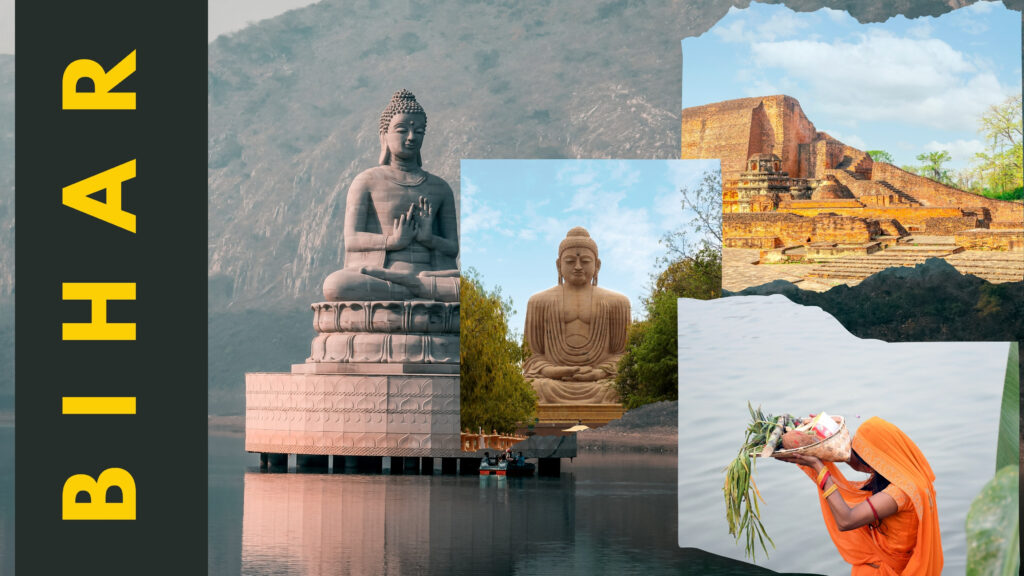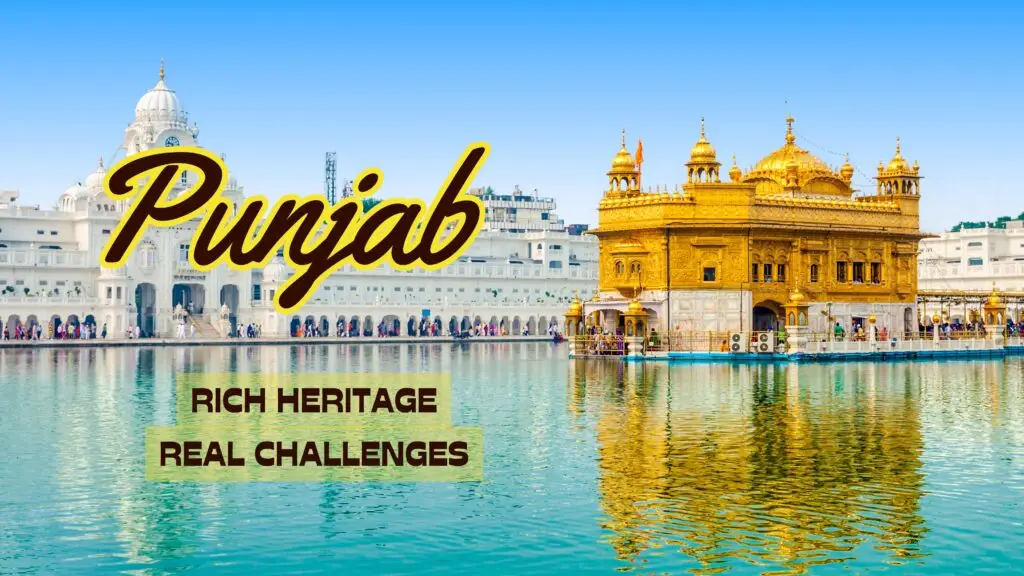Bihar is in eastern India. It is named after the ancient splendor of the nation. Human history has been determined by the land. Big empires, two major world religions, and a learning center of many years were born there. It is traversed by the sacred Ganges and its inhabitants have a very lively cultural life. Bihar is the state of great significance with both ancient and inspirational legacy.
Bihar is going in the future, however, its history is bright. It has huge issues but tackles them with courage and a definite strategy. Take a walk with us through this historic land and experience its past, its culture, its rising economy and how it is shaping a new dawn of growth.

The Cradle of Empires and Religions
India has an ancient story based on the history of Bihar. It was the seat of the Magadha Empire which spawned some of the most glorious dynasties in India.
- Mauryan Empire (321-185 B.C.E): The Magadha Empire, with its capital at Pataliputra (present-day Patna), expanded almost to encompass the entire Indian subcontinent under the rule of such emperors as Chandragupta Maurya and the popular Ashoka. The Kalinga War made Bihar a hub of Buddhism as Ashoka converted to the religion.
- Gupta Empire (320 -550 CE): The Gupta Empire was also the “Golden age of India”, and it developed extremely well in the field of science, mathematics, art and literature.
- Birthplace of Faith: Bihar is the holy place in which two major world religions started. Bodh Gaya is the birthplace of Gautam Buddha, the enlightened one and Lord Mahavira, the 24th Tirthankara of Jainism was born and enlightened there, making the place a significant religious site in both religions.
- The seat of education: The state played host to the Nalanda University, the oldest residential institution of education in the world as well as a prestigious learning hub that received students throughout the Asian continent over a period of 800 years.
This rich and deep history has made Bihar into a distinctive identity, an identity of intellectual power, spiritual piety, and deep rootedness.
Bihar’s Culture
The culture of Bihar is special mixture of strong spirituality, ancient traditions, simplicity and roughness.
- Language and Literature: The official language is the Hindi though most of the people speak regional languages and dialects. Maithili, Bhojpuri and Magahi are used throughout. The state possesses an abundance of books and poems including old religious literature and the contemporary tales.
- Festivals: Chhath Puja is the greatest festival. It is a celebration period of four days during which people show so much devotion to the Sun God. The rituals, spiritual purity and high degree of community spirit are known by the festival. There are also other festivals like Diwali, Holi, Eid and Saraswati Puja that are celebrated with lot of zeal.
- Arts and Crafts: Bihar is a mausoleum of traditional arts.
- Madhubani Painting: These popular folk art is also known as Mithila art and is a practice commonly carried out by women within the Mithila area. The artworks are made with vivid colors and geometric shapes to portray deities and stories of myths.
- Sujani Embroidery: Special type of needlework, in which tales of life, religion, and struggle are embroidered on old fabrics.
- Manjusha Art: it is a scroll painting, which narrates a chronological story. It is widespread in Bhagalpur.
- Music and Dance: Folk forms such as Bidesiya, Jat-Jatin and Sohar reveal the life of rural people. The music regularly discusses agriculture, romance, and devotion and it is straightforward and soulful.
- Food: Bihari cuisine is characterized by rather simple and rustic flavors and distinctive cooking techniques.
Geography and Environment
The fertile Gangetic Plains are majorly recognized in the state of Bihar and are divided into two unequal regions by the sacred Ganga River flowing in its center.
- Rivers: Rivers the state has numerous rivers. The major one is the Ganga, and its tributaries, e.g. the Gandak, Kosi, and Son, are its life blood, and aid its immense fields in producing food.
- Fertile Land: The Gangetic Plains have alluvial soils that are very fertile such that the majority of the population is engaged in agriculture.
- Floods: As much as the rivers are good, they are also giant trouble-makers. Rivers in the Himalayas, and in particular the Kosi, are notorious in altering their courses and causing very severe floods in North Bihar. The state government is striving to complete flood control projects such as construction of embankments and early warning systems.
There are also issues that include the logging of the trees in its limited hilly regions and pollution in the rivers with the city and factory waste, particularly in the Ganga. The government has begun various schemes to plant more trees and clean their rivers.
Livelihood and Economic Growth
Bihar economy has relied primarily on agriculture. Most people work as farmers. The state cultivates a considerable amount of rice, wheat, sugarcane and corn and various fruits and vegetables.
Of late, Bihar is taking a new direction. Now it is paying more attention to factories and services and constructing new roads and other infrastructure.
- Services Sector: The largest component of the economy is the services. IT, banks, schools and government jobs are increasing at a rapid rate and assisting the state in growing.
- Manufacturing: The industrial production is increasing. Large mills work on food (such as sugar mills and dairy), cloth and leather products. Investors are finding it easier to set up business in the government.
- Infrastructure: Bihar is constructing numerous new infrastructure. New bridges across the Ganga such as the Aunta-Simaria bridge, new highways, and improved trains and airports make travelling easier and attract more investment.
- Skill Development: The state is also undertaking to impart new skills. Bihar Start-up Policy is one of the programs which allow people to acquire skills and open businesses.
Poverty and poor income per person were problems that Bihar had to grapple with. However, now its economy is developing extremely rapidly. This is due to the emergence of new infrastructure and change to the services sector. The progress is noted in good budget rules and attention to the development of people.
Hospitality and Tourism
Bihar offers a strong sense of spiritual and historical heritage to the visitors creating a profound and distinct travelling experience. The folks here are hospitable and friendly with a rustic and simple appeal.
Spiritual Tourism
- Bodh Gaya: It is a world heritage site of the UNESCO. It possesses the Mahabodhi Temple and the Bodhi Tree, where Lord Buddha got enlightened.
- Nalanda: these are the ruins of the first university in the world where students studied on campus. It is a world heritage site and it demonstrates how good it used to be in the past.
- Rajgir: It is an old town with ancient ruins, hot springs and sites where Buddhists and Jains go and offer prayers.
- Vaishali: It was in this pre-historic city that Lord Buddha held his final discourse and the birthplace of lord Mahavira.
- Pawapuri: A Jain pilgrimage place which includes the beautiful Jal Mandir.
Historical & Cultural
- Patna: The capital city is home to ancient monuments such as the Golghar, a large granary, the Patna Museum and Takht Sri Patna Sahib, a religious site of the Sikhs.
- Vikramshila University: The site consists of the remnants of a Buddhist university of ancient times.
- Madhubani: It boasts of special Madhubani paintings.
Nature & Wildlife:
- Valmiki National Park: This is the unique tiger park in the state and allow the visitors to view its rich wildlife.
Bihar’s Delectable Flavors
Bihari food is plain, rustic and extremely delicious. It is prepared using local resources.
- Signature dish: Litti Chokha. It is a baked ball of wheat stuffed with sattu (roasted gram flour) and accompanied by spicy mixture of mashed vegetables. It is known throughout the world.
- Sattu: It is roasted gram flour that forms a central component in the Bihari food. It is consumed to prepare drinks, flat bread (parathas) and numerous snacks. It contains a sufficient supply of protein.
- Street food: The most popular snack and sweet dishes are Chura Dahi (flattened rice and yogurt), Tilkut (sesame seed sweet) and Khaja (a flaky-layered sweet).
- Sweet dishes: Sweet fried dish called Thekua and rice-flour sweet dish Anarsa are really famous and notably at Chhath Puja.
Navigating Challenges and Charting the Future
In spite of its progress Bihar has serious problems:
- Poverty and Unemployment: Even with fast growth, many people, especially in rural areas, stay poor. Creating employment to the large population of youth is a priority.
- Floods: Constant flooding of North Bihar destroys farms, roads and houses of people.
- Education and Health: Despite an improving situation, the state continues to lag behind the nation on some significant human development indicators.
- Industrialization: The state still has a very small industry, and attracting large factories to make investments is a large challenge.
But Bihar is living to work towards a better future. The government is concerned with:
- Infrastructure Improvement: You spend much on roads, bridges and electricity in order to make travelling easier.
- Agriculture Development: Revision of farming practices, promotion of alternative crops and enhancing irrigation.
- Human Capital Development: investing in schools, skill development and health care.
- Industrial Promotion: The assistance of the food processing, textiles and other factories to generate jobs.
- Tourism Development: It applies its religious and historic sites to bring more visitors.
The Unwavering Spirit of Bihar
Bihar is a state that demonstrates what it is being resilient and bringing back to life. Its history is rich, traditions are strong and people are determined. On its way, the state demonstrates that in a land where people have many old struggle to get through, a plan and a strong spirit may create the future where the world would be peaceful, flourish, and have an unlimited number of opportunities.




